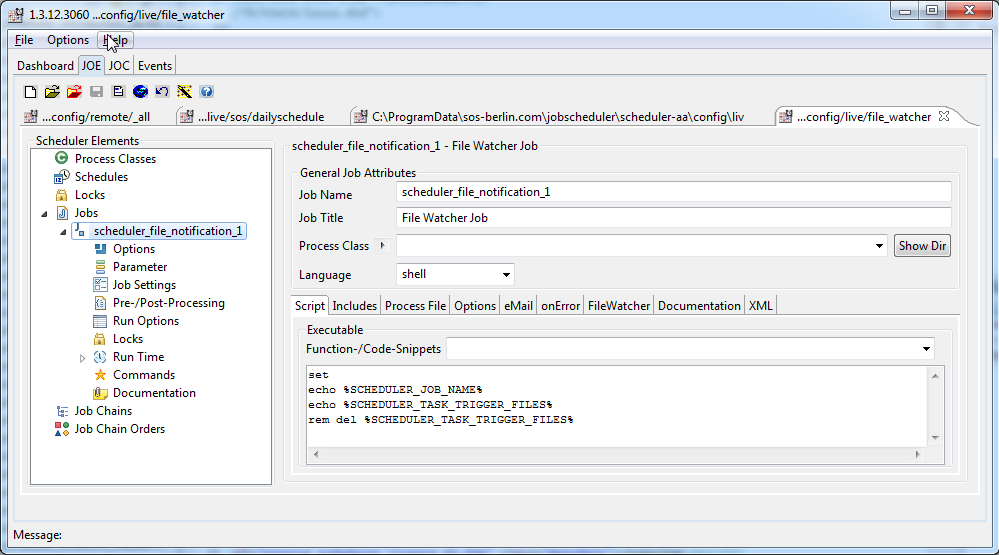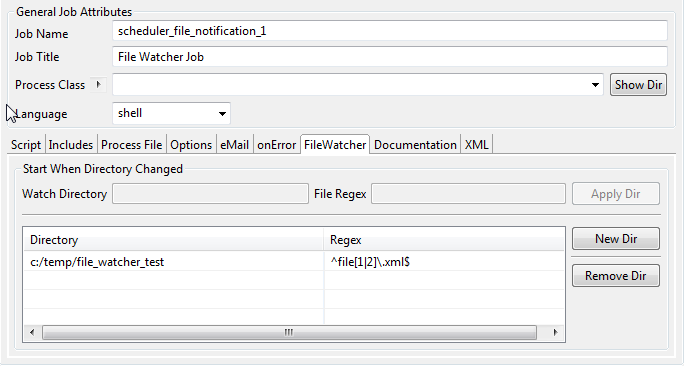| Table of Contents |
|---|
...
Directory Monitoring
...
| Excerpt |
|---|
JobScheduler can monitor file creation |
with a (standalone) job and with an order (and a job chain). |
For further information on how to use file watching with a job chain we recommend reading Directory Monitoring with File Orders.
This job can then start a job chain or job group.
An example how to configure a "file-watcher":{{
<job name = configuration for monitoring a directory:
| Code Block | ||
|---|---|---|
| ||
<job name = "scheduler_file_notification_1"> |
...
<script language="shell" |
...
> <![CDATA[ |
...
set echo %SCHEDULER_JOB_NAME% |
...
echo %SCHEDULER_TASK_TRIGGER_FILES% |
...
rem del %SCHEDULER_TASK_TRIGGER_FILES% |
...
]] |
...
> </script> |
...
<start_when_directory_changed directory = "c:/temp" regex = "^file[1|2]\.xml$"/> |
...
</ |
...
job>
|
This job will watch monitor the folder "c:/temp" on a ms-windows system. Every event regarding the files "file1.xml" and/or "file2.xml" will fire the execution of the embedded script (in this case it will echo some values for JS-Environment Variables).Windows® operating system. The regular expression is used to define which file(s) JobScheduler has to watch. In this example the regular expression means that on a directory change (deleting, renaming, adding any file) the job will be startet when the files file1.xml and/or file2.xml is in content of the directory.
The SCHEDULER_TASK_TRIGGER_FILES environment variable contains the names of all the files in the c:/temp folder that matches the regular expression at the time when the directory was changed- it does contain the name of the file that triggered the embedded script only in the case the file matches the regular expression. The file names are maintained in a semicolon separated list.
Note that this behaviour could be critical when two files (e.g. file1.xml and file2.xml) are created at the same time.
- Two tasks will then be started for the job.
- In the first task the environment variable SCHEDULER_TASK_TRIGGER_FILES will have the value
c:/temp/file1.xml;c:/temp/file2.xml. - In the second task the environment variable SCHEDULER_TASK_TRIGGER_FILES will have a value that depends on what the first task has done with the files.
- If, for example, the first task deletes the files in
c:/tempthen SCHEDULER_TASK_TRIGGER_FILES will be empty for the second task.
Set up as a standalone job in the JobScheduler Editor JOE the script will look like this:
The directory settings and regular expression settings are entered in the 'FileWatcher' tab in JOE as follows:
For further information on how to use file watching with a job chain we recommend reading Directory Monitoring with File Orders.
See also
- Environment variable (JobScheduler Reference handbook)
- Directory Monitoring (JobScheduler Reference handbook)

